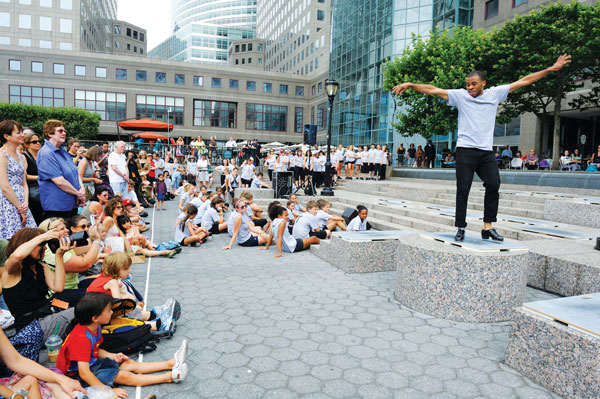
The Restaurant Week menu at Danny Meyer’s North End Grill includes chilled cucumber soup with hearts of palm and cherry tomatoes. A three-course lunch there during Restaurant Week costs $24.07.
BY TERESE LOEB KREUZER | Deal-dining in B.P.C.: Three Battery Park City restaurants are participating in Restaurant Week, offering discounted meals through Fri., Aug. 10. Three-course lunches cost $24.07, and three-course dinners are $35. Tax, tip and beverages aren’t included in the deal.
2 WEST, in the Ritz-Carlton hotel (2 West St.), a member of this year’s restaurant week, is offering discounted lunches and dinners. The Atrio Bar & Restaurant in the Conrad New York hotel (102 North End Ave.), is offering lunch, dinner and Sunday dinner. Danny Meyer’s North End Grill (104 North End Ave.) is also serving lunch as part of Restaurant Week.
At North End Grill, à la carte lunch entrées regularly cost $18 to $33. The three-course Restaurant Week menu is a delicious bargain. A chilled cucumber soup served with hearts of palm and cherry tomatoes is infused with subtle Indian spices. For a second course, the spiciness of chili-rubbed rock cod is set off by a sweet mélange of roasted corn and onions. Pistachio cheesecake with plums makes a creamy and satisfying finish.
North End Grill’s ambiance is pleasant and low key, with tables set far enough apart for conversations to remain private. The service is distinguished.
For more information about Restaurant Week and to make reservations, visit www.nycgo.com/restaurantweek/.
South Cove sinks: For reasons yet to be determined, a sinkhole — a sizeable crater in the ground — has developed in South Cove, on the south side of the wooden pier that juts out into the river. The Battery Park City Authority has hired the SDL Group, a Queens-based contractor, to trace the cause of the problem. The cost of the repairs will be determined after the initial excavation and assessment, which are due to begin on July 23.
While this work is in progress, part of South Cove’s lower level will be closed off. People with mobility issues should use the upper level. In early July, the B.P.C.A. put up safety barriers and reflective cones in order to keep people away from the sinkhole.
Recently, a sinkhole in the nearby Wagner Park was repaired. Matthew Monahan, a spokesperson for the B.P.C.A., said the two sinkholes are completely unrelated. “At Wagner, it was caused by a cracked underground drainage pipe,” he said. “No pipe is near the South Cove location.”
M.T.A. to restore B.P.C. bus service: The M9 bus, which disappeared from Battery Park City in 2010 during the Metropolitan Transit Authority’s draconian service cuts, will be back next January.
B.P.C. will be one end of a route that will connect Chinatown and City Hall with the East Village and the Lower East Side, much as the service did prior to the cuts. In addition, the M9 will now continue north to Bellevue Hospital and the N.Y.U. Langone Medical Center at 34th Street.
The restoration of the M9 is one of several transportation service improvements in the offing. Five new bus lines have been proposed, including one that would run along the far west side of Manhattan, connecting the West Village, Chelsea, Hell’s Kitchen and Clinton. That route is supposed to open in September 2013.
The service additions will cost the M.T.A. $29 million a year, which it expects to recoup with increased ridership. Pending a public hearing, the city also hopes to increase fares starting in March 2013.

Tap City: On July 13, as part of the River to River Festival, 150 tap dancers showcased their moves in three free performances on the World Financial Center’s outdoor plaza. Many of the dancers, who ranged in age from 7 to 75, are students at a tap dancing school run by the American Tap Dance Foundation at 154 Christopher St. Others were professional dancers.
The performance, called “Tap City,” was put on by the American Tap Dance Foundation’s founder, Tony Waag, who conducted. It was the tap ensemble’s first appearance at the River to River Festival.
Most of the dances were performed without musical accompaniment. In one number, a saxophonist led the dancers onto the stage, like the Pied Piper, and then accompanied their rat-a-tats resounding off the metal plates that had been strewn across the plaza steps. Another number, which sounded like a jazz gig, featured a drummer who “tagged” one dancer after another with her drumming, causing the selected ones to tap out a short solo.
Tap dancing seems to have grown out of an amalgamation of African drumming and Irish step dancing. Interestingly, some of tap dancing’s antecedents were in Lower Manhattan. In the mid-19th century, the infamous Five Points slum near what is now Columbus Park was home to both Irish-Americans and African-Americans. They engaged in dance contests and incorporated each other’s steps into their own dancing. An African-American dancer, William Henry Lane, who called himself Master Juba, astonished everyone who saw him with his tap dancing. In 1841, Charles Dickens was among those who saw him dance, calling him “the greatest dancer known.”
Juba died in 1852 at the age of 27, but some of his dance routines are still performed.
Battery Park City in bloom: If the cardoon (Cynara cardunculus), resembles an artichoke, that’s because it’s a close relative. Its striking purple flowers can now be seen on the southern flank of Wagner Park. Cardoon, domesticated for more than 2,000 years, was used as food by the ancient Greeks, Romans and Persians. From Europe, cardoon (also called “artichoke thistle”) made its way into colonial American vegetable gardens. Stems were braised and leaf stalks — steamed or braised —were said to taste like artichokes.
Cardoon enzymes can be used for cheese production. Oil extracted from cardoon seeds resembles safflower and sunflower oil.
How long will B.P.C.’s cardoon continue to bloom? “That depends on the weather,” according to Eileen Calvanese, B.P.C. Parks Conservancy’s head horticulturist.
The cardoon flourishes in dry climates. It is native to the western and central Mediterranean.
To comment on Battery Park City Beat or to suggest article ideas, e-mail Terese Loeb Kreuzer at TereseLoeb10@gmail.com.































